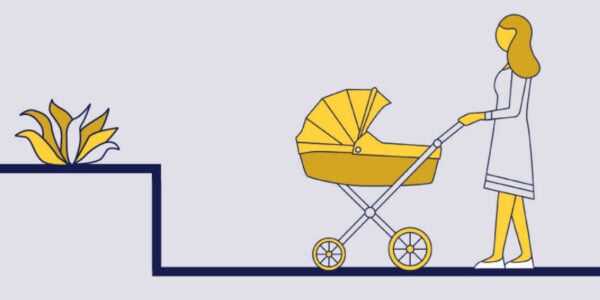About
The removal of a newborn baby from his or her mother at birth in response to safeguarding concerns is an emotionally charged and highly contentious issue.
The number of newborn babies in care proceedings in England and Wales has increased over the past decade (Broadhurst et al. 2018; Alrouh et al. 2020) and further national guidance is needed to address many unresolved ethical and practical dilemmas that arise when the state intervenes at birth.
This summary highlights the key findings from a study exploring compulsory intervention at birth from the perspectives of parents as well as professionals in children’s social care, health services and the courts (Mason et al. 2022a):
• pre-birth –referral, assessment and support
• maternity setting – in the maternity ward and at first court hearing
• following the return home – support given to parents as they leave hospital and return home, without the baby, and often alone.1
The findings form the basis for constructing local area action plans to address the identified system-level challenges and for developing and piloting practice guidelines designed to introduce more sensitive and humane practice when the state intervenes at birth.
Key findings
Our study found considerable consensus between both professionals and parents as to what constitutes best practice when the state intervenes to safeguard a baby at birth. However, the study also identified numerous challenges that continue to stand in the way of best practice.
Information sources
This report draws on data collected through in-depth interviews with 44 parents (38 mothers and 6 fathers), most of whom had experienced being separated from their babies at a maternity setting, either at or close to birth. A small number had been placed in a parent and baby facility for further assessment. Data from parents was complemented and illuminated by findings from focus groups and interviews conducted with 263 midwives, social workers, social work managers, Cafcass workers, local authority lawyers and foster carers in 6 local authorities and NHS Trusts in England, and 2 local authorities and an NHS trust in Wales.
Cross-cutting challenges
- Resource constraints in terms of austerity measures and cuts to social care and health services have reduced preventative services and led to high thresholds for support and long waiting lists. In some authorities, services that were previously introduced to support parents to make positive changes during pregnancy, or to support them after their baby was removed, were no longer available. Resource constraints have also affected legal proceedings because the low fees attached to preproceedings work mean that parents receive a fragmented service, and frequently fail to access the skilled advocacy they need. Limited availability and high costs associated with alternatives to separation were also highlighted by professionals and parents as significant constraints.
- Discontinuities and turnover of key professionals that are partly attributable to resource constraints have made it harder to retain social work staff and increased the likelihood that agency workers will be employed. However, other discontinuities are built into children’s social care and maternity services: parents and professionals described a system in which parents move from one practitioner to another as they pass through different parts of the systems. Discontinuities and staff turnover have made it harder to establish a trusting relationship with parents whose life experiences have been marked by transience. They also impede collaborative working between agencies, and partnership working under the Public Law Outline.
- Delays and time constraints were found to be a major challenge. Delays in identifying need, offering early help and referring pregnant women to children’s social care meant that opportunities to support parents to make positive changes were lost. Some delays were incurred by a rigid adherence to inappropriate timeframes and a two-stage assessment process that left little time for accessing specialist services. Delayed referrals and social worker churn also meant there was little time to establish evidence of parents’ capacity to change, and too much weight was given to their past histories. Delays in making decisions and sharing plans resulted in parents being ill-prepared for court. Such delays had
implications for parents’ ability to benefit from robust legal advice and participate fairly in a first court hearing. Some mothers (and some midwives) did not know that the plan was for removal at birth until after the baby was born. Delayed decisions could also have meant too little time to find a mother and baby placement or other provision, thereby increasing the likelihood of separation. - Resource constraints, discontinuities and delays posed extensive challenges throughout all three stages of the process (pre-birth, in the maternity ward and following the return home). They had a knock-on effect on one another and tended to exacerbate the numerous other challenges to best practice.
- Professionals were aware of the importance of including mothers, fathers, grandparents and other family members in decision-making and planning, but there were shortfalls in family-inclusive practice throughout all three stages. Although some authorities had introduced family group conferences as an intrinsic element in their child protection pathways, others had not. The fathers who participated in interviews felt routinely marginalised, and in at least one authority they were not included in decision-making and planning until issues of paternity had been resolved. Little use was made of family networks to help mothers during the pregnancy, to support them or provide supervision on the ward if it was required, or to provide practical and emotional support when they returned home from hospital. Some parents had histories of violence, but there were concerns that in other cases, risk-averse attitudes had unnecessarily prevented fathers and other relatives from visiting mothers and babies on the ward or being present at the birth.
Specific challenges at pre-birth stage
- Most parents had multiple experiences of trauma and loss, including the removal of previous children, prior to this pregnancy. However, while social workers recognised parents’ difficult histories, trauma and repeat child removal were insufficiently addressed as specialist issues. Resource constraints have led to a lack of specialist expertise. Practitioners in non-specialist teams were aware that they were unable to give sufficient attention to the needs of parents whose previous experiences had often led them to mistrust professionals, but they were constrained by service structures and heavy caseloads. In busy generic social work teams, it was not always possible to prioritise the unborn child.
- Unresolved legal dilemmas included the use of voluntary agreements under the Children Act 1989, Section 20 (Social Services and Well-being (Wales) Act 2014, Section 76). On the one hand, these potentially offer an opportunity to safeguard the baby while social workers work proactively with parents to improve their parenting capacity. Voluntary agreements also avoid the need for court hearings at a time when mothers may not be physically or psychologically able to participate meaningfully. On the other hand, some parents considered that they had been coerced into
signing them. When there was no plan for reunification it was considered unethical by parents and indeed some professionals to use this provision to gain time to prepare papers for a court hearing. - There were also dilemmas concerning the ethics of encouraging
parents to invest financially and emotionally in equipment for a baby from whom they were likely to be separated. Social work assessments require evidence that parents are preparing for their baby, and this includes practical preparation. However, the emotional impact on parents of returning alone to a home full of baby items was insufficiently acknowledged.
Specific challenges within the maternity setting and at the first court hearing
- Time and resource constraints and lack of specialist care led many
mothers on the postnatal maternity ward to experience acute feelings of shame and stigma. While some mothers were offered a side room, others remained in a communal bay while social workers, solicitors and midwives sometimes discussed highly sensitive legal and medical issues with little regard for their privacy. - The practice of instigating court proceedings immediately after the birth meant that parents had few opportunities to focus on bonding with their babies when their energies were taken up with navigating safeguarding and legal processes. The requirement for mothers to attend court within hours or days of giving birth posed considerable practical and emotional difficulties, and also meant that they had little capacity to take in vital information or to adequately instruct a solicitor. Mothers also faced the impossible choice of either attending the hearing (and missing out on precious time with the baby) or staying with the baby and risking giving the court the impression that they were not taking the proceedings
sufficiently seriously. - Shortfalls in practice also included inadequate planning, time, choice and support at the point of separation. It was helpful for parents to meet foster carers before the birth or at the very least in advance of the separation, but this was often not possible. Choices over details such as who they would hand the baby to, and what the baby would wear, were of great significance to parents who had so little power over lifechanging decisions. However, in a system focused on the legal process, professionals had little time for these sensitive discussions.
Specific challenges on leaving hospital and returning home
- Following discharge from hospital, many mothers fell into a support
vacuum with no professionals having responsibility for their care. Some had to face leaving hospital alone and returning to an empty home with no one to comfort them. - In areas without specialist teams there might be no continuity of
midwifery care. Many mothers who returned home without their babies found it difficult to accept routine postnatal care; some also missed out on later postnatal services offered by primary care, with adverse consequences for their long-term physical and mental well-being. - Contact arrangements were often made without consulting parents or considering their circumstances, and without taking into account the possibility of reunification
- Parents were more positive about mother and baby foster placements than residential assessment centres. However, budgetary or recruitment constraints meant that these were in short supply and not always of sufficient quality to provide parents with adequate support.
Examples of good practice
Despite the numerous obstacles there were nevertheless several examples of good practice, and in some cases, considerable evidence of progress in addressing some of the system-level challenges. These included:
- the provision of specialist multidisciplinary teams to support the parents throughout the pregnancy and sometimes beyond
- dedicated pre-birth social work teams to ensure timely specialist
assessments and coordinated intervention plans - pre-birth pathways in early help to try to address concerns regarding late intervention
- amended protocols designed to better align service responses with parents’ needs
- bespoke recurrent care services for parents who had previously
experienced the removal of a child - imaginative use of foster carers to plug the gaps in family support
services.
Next steps
When looking across all elements of the parent and baby journey, from prebirth through to returning home and placement, the study uncovered several cross-cutting challenges. These included discontinuities, delays, resource constraints, risk averseness, a lack of family-inclusive practice, insufficient professional expertise and poor inter-agency collaboration.
The team found considerable variation across the participating research
sites, but there was marked consensus among professionals that, at present, services are not consistently offering a sufficiently timely or effective response to either divert babies from care proceedings, or to ensure that decision-making is sufficiently robust. The window of opportunity to support parents during pregnancy is being missed in too many cases, where practice is insufficiently change-oriented, and focuses narrowly on the assessment of risk.
There was, however, considerable consensus across the range of
professionals consulted, as well as from parents, as to what constitutes best practice in this difficult area. The good practice examples illustrate that change is possible. However, what is also clear is that, in general, principles of best practice are insufficiently embedded throughout organisations. Rather, they result from the efforts and insights of individuals whose own expertise and motivation drives them to work in a different way. As a result, currently too much is left to chance.
References
Alrouh, B., Broadhurst, K. and Cusworth, L. (2020). Women in recurrent care proceedings in Wales: a first benchmarking report. Nuffield Family Justice Observatory. https://www.nuffieldfjo.org.uk/resource/women-in-recurrentcare-proceedings-in-wales-a-first-benchmarking-report
Broadhurst, K., Alrouh, B., Mason, C., Ward, H., Holmes, L., Ryan, M. and
Bowyer, S. (2018). Born into care: Newborns in care proceedings in England. Nuffield Family Justice Observatory. https://www.nuffieldfjo.org.uk/resource/born-into-care-newborns-in-care-proceedings-in-england-final-reportoctober-2018
Mason, C., Broadhurst, K., Ward, H., Barnett, A. and Holmes, L. (2022a). Born into Care: Developing best practice guidelines for when the state intervenes at birth. Nuffield Family Justice Observatory. http://www.nuffieldfjo.org.uk/resource/born-into-care-developing-best-practice-guidelines-for-whenthe-state-intervenes-at-birth
Mason, C., Broadhurst, K., Ward, H., Holmes, L. and Barnett, A. (2022b). Born into Care: Draft best practice guidelines when the state intervenes at birth (pilot version). Nuffield Family Justice Observatory. http://www.nuffieldfjo.org.uk/resource/born-into-care-best-practice-guidelines-when-the-stateintervenes-at-birth-pilot-version
Pearson, J., Jay, M., O’ Donnell, M., Wijlaars, L. and Gilbert, R. (2020).
Characterizing newborn and older infant entries into care in England
between 2006 and 2014. Child Abuse & Neglect, 109. https://doi.
org/10.1016/j.chiabu.2020.104760
-
 The Centre for Child and Family Justice Research
The Centre for Child and Family Justice Research -
 Lancaster University
Lancaster University -
 Rees Centre, University of Oxford
Rees Centre, University of Oxford -








